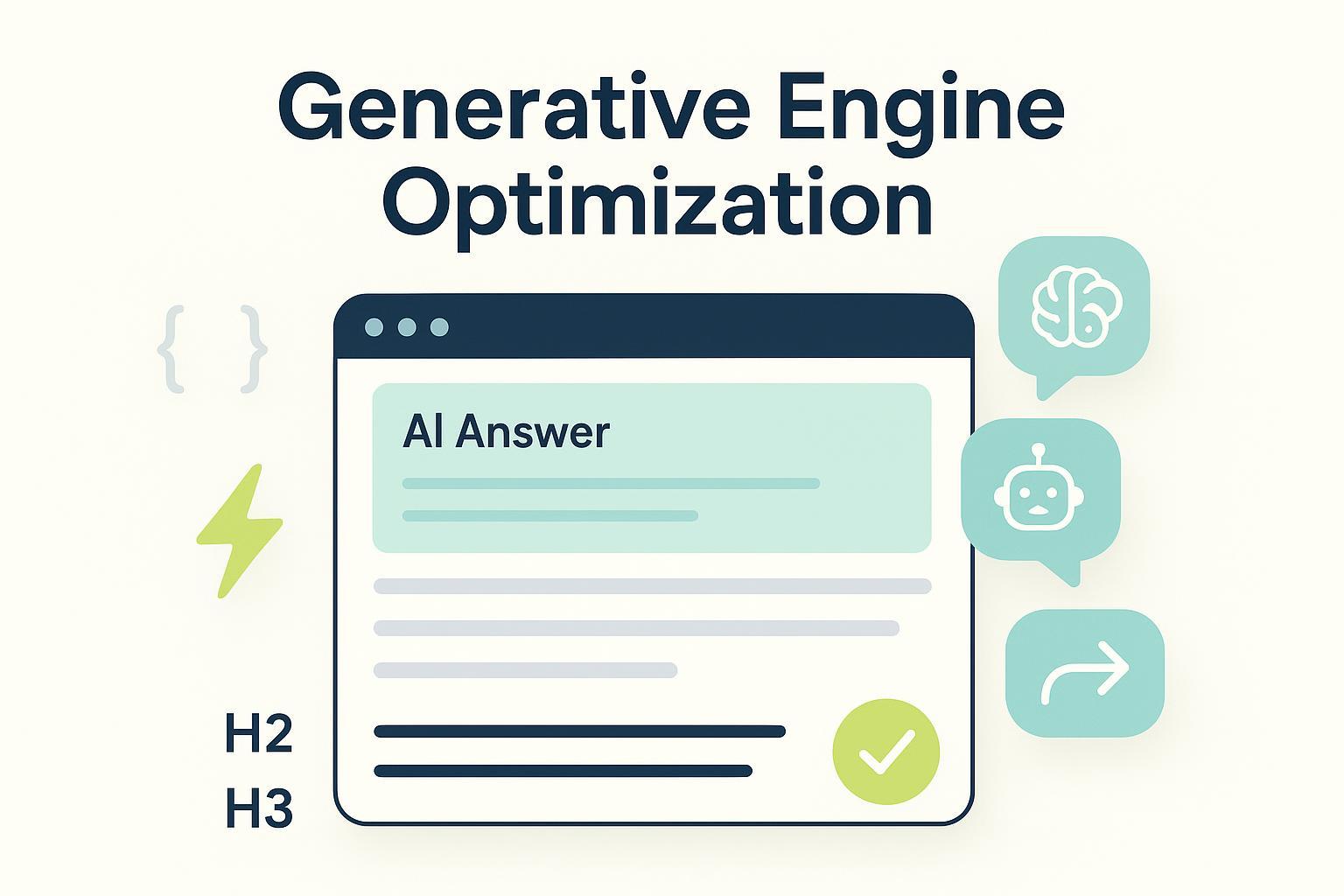Using Schema Markup to Influence AI Answers
Schema markup helps AI understand your content, improving search visibility, rich snippets, and voice search results for better user engagement.


Schema markup helps connect your content to AI search engines. It makes your website’s information easier to understand. Adding structured data helps AI find exact answers and boosts visibility. Websites with schema markup often get more clicks because of better search results. Over 45 million websites now use structured data, showing its rising value in SEO. As AI leads in search, schema markup keeps your content noticeable and useful.
Key Takeaways
Schema markup helps search engines understand your content more easily. This can improve how often people see and click it.
Choosing the right schema types makes your website look better in search results. This can attract more users to your site.
Testing and updating your schema often keeps it accurate. This helps AI give better answers and boosts your site's performance.
Adding schema markup can help your site show up in rich snippets and voice search results more often.
Using advanced schema types for new AI trends can make your content stand out in search rankings.
What Is Schema Markup?

Definition and Purpose
Schema markup is structured data that helps search engines understand websites. It works like a special code that organizes your page details. This includes things like product info, recipe steps, or event dates. It gives clear hints about your content to AI search engines. These hints help AI show the right information in search results. For example, a recipe blog can use schema markup to highlight prep time, calories, and ingredients. This makes it easier for users to find your recipes quickly.
Adding schema markup improves how your site appears in searches. It lets search engines show rich snippets, like reviews or FAQs, directly in results. This boosts clicks and brings more visitors to your site. Businesses using schema markup stand out in crowded search results and gain an advantage.
How It Works with AI Search Engines
AI search engines need structured data to understand and organize websites. Schema markup acts like a guide, helping AI connect related information. For example, using schema markup creates a knowledge graph. This graph links data points, making it easier for AI to use your content.
A law firm showed how this works. They used LegalService schema to mark office locations and service areas. This helped them rank higher for searches like “best personal injury lawyer near me.” It shows how schema markup improves local searches and rankings.
Common Types of Schema Markup
There are different types of schema markup, each for specific content. Here are some examples:
Article: Marks blog posts, news, or written content.
FAQPage: Organizes questions and answers for better search visibility.
Product: Shows product details like price, stock, and reviews.
Event: Shares event info, such as dates, places, and tickets.
Person: Highlights profiles of people, like authors or experts.
Big companies often use many schema types, like Organization, Event, and Article. This shows their knowledge and expertise. Solo professionals, like lawyers, may use Person and LegalService schemas. This helps them rank better locally and show their skills in specific fields.
Best Practices for Combining Schema Markup and AI
Enhancing Data Accuracy
Correct data helps AI give better answers to users. Schema markup makes your website’s information clear and easy to trust. Choosing the right schema types helps AI understand your site better. For example, healthcare websites using schema markup gained 30% more visitors and 40% more leads. Financial services also saw a 20% traffic increase by fixing their data with structured markup.
To improve accuracy, match your schema markup to your content goals. Use tools like Google’s Structured Data Testing Tool to check for mistakes. This ensures your schema works well and fits what users search for. Accurate data boosts your SEO and helps AI show your content more often in searches.
Optimizing for Rich Snippets
Rich snippets make your website stand out in search results. They show extra details like reviews, prices, or FAQs that attract clicks. Schema markup helps create these special search features. Websites using structured data have seen an 82% higher click rate for rich results. Rotten Tomatoes improved their click rate by 25% after adding schema markup.
To get rich snippets, use schema types like FAQPage, HowTo, and QAPage. These work well with AI searches and increase your chances of being featured. Check your website’s performance with tools like Google Search Console to see how schema affects visibility. Better snippets bring more visitors and keep them engaged.
Structuring Content for Voice Search
Voice search is growing fast in AI-powered searches. To succeed, your content needs to answer conversational questions. Schema markup organizes your data so AI can understand it easily. Pages with short answers and question-based headings are 38% more likely to appear in voice searches. Over 40% of voice search answers come from featured snippets.
To prepare for voice search, use schema markup to highlight key info like FAQs or local business details. Businesses that focus on voice search saw a 41% rise in local conversions and a 28% increase in time spent on their site. Using voice-friendly schema types helps AI connect with your content and improves your search rankings.
Practical Steps to Implement Schema Markup

Matching Content to Schema
The first step is linking your content to the right schema. Start by finding important pages on your site that need structured data. These could be product pages, blogs, or service details. Match these pages with the correct schema types from Schema.org. For example, use Product schema for online store pages or FAQPage schema for Q&A sections.
Follow these steps to match content with schema:
Find key pages for adding schema.
Choose the right schema types for your content.
Add schema using JSON-LD or other formats.
Test your schema for mistakes.
Track results and make changes if needed.
Keep up with updates to schema rules.
Tip: Use schema to show details like hours, reviews, or deals. This helps search engines and gives users helpful info directly in search results.
For instance, a bakery can use LocalBusiness schema to show its address, phone number, and hours. This makes it easier for AI to share accurate info, improving visibility and user interaction.
Using Tools to Create and Check Schema
Tools make creating and checking schema easier. They help you build schema, find errors, and follow search engine rules. Tools like Google’s Structured Data Markup Helper and Schema Pro let you create schema without needing coding skills.
Here’s how tools help with schema:
Find Errors: Tools show missing info or mistakes in your schema.
Follow Rules: They check if your schema meets SEO standards.
Boost Rich Snippets: Correct schema increases chances of showing rich snippets, which get more clicks.
For example, a travel site using TouristAttraction schema can check its data to ensure AI uses it correctly. This improves search results and user engagement.
Note: Always check your schema after creating it. Use tools like Google’s Rich Results Test to confirm your data works and qualifies for rich results.
Testing and Fixing Schema
Testing and fixing are key to making sure your schema works. After adding schema, use tools to find and fix problems. Fixing errors helps AI understand your data better.
Important things to track during testing include:
Metric | What It Shows |
|---|---|
Check if CTR improves after adding schema. | |
Impressions and Rankings | See if your site gets more views and ranks higher. |
User Engagement | Look at bounce rates and time spent on your site. |
Tip: Test your schema often, especially after site updates. Fixing issues keeps your data accurate and useful.
For example, a restaurant using Menu schema can test if menu items and prices show correctly in searches. This ensures accuracy and gives users clear, helpful info.
Measuring Success with Schema Markup
Tracking Performance Using GA4
Google Analytics 4 (GA4) helps track how schema markup works. It shows important data like clicks, views, and user activity. This helps you see if structured data improves search results. For example, adding schema to a product page can boost clicks. GA4 will show if more people click on your rich snippets.
Start by setting up custom events in GA4 to track schema. Check how often users interact with your site after seeing it in searches. This info helps you adjust your content and improve accuracy. Reviewing GA4 reports often ensures your schema matches your SEO goals and boosts AI visibility.
Monitoring Rich Snippets and Visibility
Rich snippets come from using schema markup correctly. They make search results better by showing extra details like reviews or prices. Watching these snippets helps you measure success. Tools like Google Search Console show which pages create rich snippets and how they perform.
Schema markup increases the chance of getting rich snippets in searches. These snippets give users more details and make your content stand out. For example:
Structured data adds rich snippets to regular search results.
Rich snippets improve clicks and keep users interested.
A strong knowledge graph makes your site more noticeable.
By checking your rich snippets, you can find ways to improve your schema. This keeps your content competitive in AI-powered searches.
Evaluating AI-Generated Answers
AI search engines use schema markup to give accurate answers. Checking how AI uses your data is key to measuring success. Look for your content in AI results, like featured snippets or voice searches. These show that your schema is working well.
Focus on metrics like visibility and user activity to check AI use. For example, FAQ schema can help AI answer common questions. This may lead to more visitors and longer time spent on your site. Soon, AI tools might even automate schema creation to keep up with trends.
By reviewing AI-generated answers often, you can improve your schema. This helps you stay ahead in the fast-changing world of AI search engines.
Future Implications for Schema Markup in AI Search Engines
Emerging Trends in AI and Schema
Schema markup has grown from a simple SEO tool to a key part of AI. As AI search engines improve, schema helps connect data to smart systems. Fabrice Canel from Bing stressed its value in his 2023 talk. He explained how schema prepares sites for AI-powered searches. Yet, many teams still use only basic schema types out of the 811 available.
To stay ahead, try advanced schema types that match new AI trends. For example:
Schema now supports generative search, giving users more personal results.
AI search engines use structured data to create knowledge graphs. These graphs make websites more visible to AI.
Businesses using detailed schema plans gain an edge in AI-driven searches.
By following these trends, you can make your content ready for the AI-first future.
Preparing for Conversational AI
Conversational AI is changing how people use search engines. Schema markup helps by making data clearer and improving voice search results. Studies show structured data helps AI sort content better. This makes it easier to answer spoken questions.
Aspect | Evidence |
|---|---|
Data Accuracy | Schema improves data accuracy, helping AI sort content better. |
Voice Search Optimization | It helps AI understand content for better voice search answers. |
Targeted Information | Clear schema boosts chances of showing up in voice searches. |
To get ready for conversational AI, focus on schemas like FAQPage and QAPage. These schemas highlight questions and answers, which AI uses for conversations. Businesses using voice-friendly schema often see more engagement and local sales.
Adapting to AI-First Search Strategies
AI-first search needs a new way of using schema markup. AI looks for content with experience, expertise, authority, and trust (E-E-A-T). Adding schema types that show these traits can boost your visibility.
Try these steps:
Add author and reviewedBy schema to show content is trustworthy.
Use fact-check panels to ensure your info is correct.
Link to trusted sources to improve your credibility.
AI search engines prefer content that is reliable and expert. By updating your schema to meet these needs, you can improve your strategy and stay ahead in AI-powered searches.
Schema markup helps AI understand your website better. It organizes your data so tools like ChatGPT and Google Assistant can find it easily. This makes your site more likely to show up in rich results, like featured snippets. These results get more clicks and keep users interested.
Platforms like Perplexity and Claude use clear schema markup to give faster and better answers to users.
Using schema markup gives your site an advantage. It makes your content easier to find and works well with AI tools. Start using schema now to stay ahead in AI-powered searches.
FAQ
What’s the simplest way to add schema markup?
Use tools like Google’s Structured Data Markup Helper or Schema Pro. These tools are easy to use and don’t need coding. They help you make, check, and add schema markup fast.
How does schema markup make my site more visible?
Schema markup organizes your site’s data for search engines. It helps AI understand your content, leading to better rankings. This brings more clicks and makes your site stand out.
Can schema markup help with voice search?
Yes! Schema markup highlights important info like FAQs or business details. AI uses this data to answer spoken questions, improving your chances in voice searches.
Should I update schema markup often?
Yes, updating schema keeps your data correct and up-to-date. Regular updates help you follow AI trends and stay visible in search results.
Is schema markup only useful for big companies?
No, businesses of all sizes can benefit from schema markup. Small businesses can use it to rank higher locally and get more customers. Even one schema type can make a big impact.
See Also
Strategies for Excelling in AI Search Optimization 2025
Achieving High Rankings in AI Overview Searches
Conducting Brand Audits for AI Overview Success
Understanding AI Search: Its Functionality and Purpose
Enhancing Brand Visibility Through Effective Prompt Engineering





